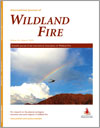International Journal of Wildland Fire
Volume 23
Number 6 2014
Simulations with a coupled weather–wildland fire model and airborne infrared imagery were used to investigate the 2006 Esperanza wildfire. Fire growth was directed by Santa Ana winds that were channelled by mountain ranges, accelerated over peaks and driven across canyons, and by the fire drawing itself up drainages. Simulations captured observed fire spread west-south-westward, splitting of the head, flank runs and feathering at the leading edge.
A high-intensity wildfire burnt through a dry Eucalyptus forest that had been fuel treated 3 months prior. Carbon loss and greenhouse gas emissions were measured after wildfire, both with and without prior fuel reduction burning. The paper discusses the benefits of prescribed fire in reducing wildfire emissions.
Dominant drivers of biomass burning have varied throughout the Holocene with early–mid Holocene fire controlled by fuel availability, climate and vegetation type. Anthropogenic controls on fire dominate mid–late Holocene biomass burning, initially through an increase in ignitions and subsequently through a reduction in human-induced ignitions and active fire suppression.
We evaluate the rate of smoking-caused wildfires as a function of weather, other ignitions, adult smokers, improved wildfire cause-determination methods and sale of less fire-prone cigarettes. We find a reduction in smoking-caused wildfires by 23% from less fire-prone cigarettes, 48% from improved cause classification and 9% from the decline in adult smokers.
This study identifies the factors that contribute to the spatial pattern of ignition occurrence and frequency across Southern California’s National Forests. The resulting regression models show good agreement with the observations and partially explain the observed patterns of burned area in the region.
In this paper, daily area burned records from 18 Portuguese districts are analysed. A time series clustering approach that combines extreme value theory and classification techniques is adopted for the analysis of the extreme area burned and regional variability in Portugal from 1980 to 2010.
We consider a new methodology for making effective strategic deployment decisions for wildfire initial response planning. This methodology includes a fire behaviour simulation, a wildfire risk model, and a probabilistically constrained stochastic integer programming model. A study based on the District 12 in East Texas involving dozers is reported.
Eastern red cedar (Juniperus virginiana) is expanding beyond its historical range. Prescribed fire is needed to reduce wildfire risk and invasion. Hotter fires and lower live fuel moisture (LFM) increase J. virginiana ignition. LFM <60% represents a threshold of rapid ignition, greater flame lengths, higher fuel consumption and increased risk.
This paper investigates the potential effect of forest fire on mass movements. Statistically correlating inducing and preconditioning factors for mass movements showed that the burned severity, being an inducing factor, was one of the main factors affecting mass movement in addition to soil and rainfall.
This paper quantifies the limitations of using time since fire as a surrogate for fire hazard in biodiverse, Mediterranean-type shrublands. A new rapid, field-based technique for estimating fuel loads is presented that provides more accurate results than time since fire and has application in fire-prone shrubland communities worldwide.
We describe effects of fires of various severities on biomass and fuel characteristics for a typical dry Scots pine forest in central Siberia. Post-fire accumulation of different components of above-ground biomass was related to both fire severity and time since burning. Such data provide a basis for quantifying and modelling post-fire fuel dynamics and carbon stocks.
In this study, a new assessment of householder preparedness for wildfire that can be used by householders, practitioners and researchers was developed. This tool focuses on preparedness to (i) evacuate, (ii) actively defend the property and (iii) improve the prospects of a house surviving a fire with no defender present.




